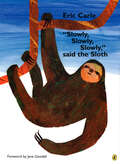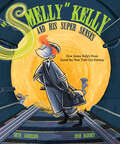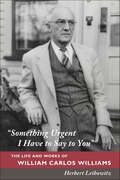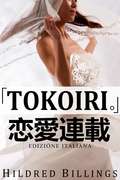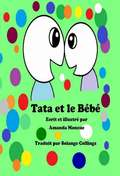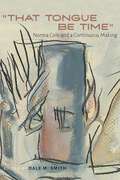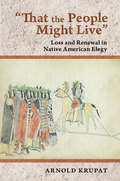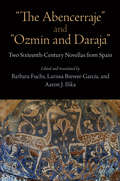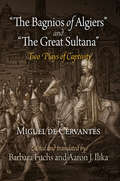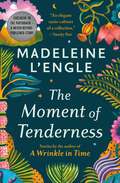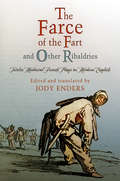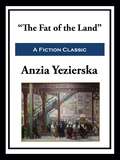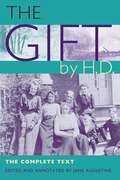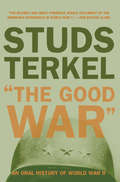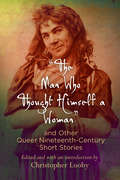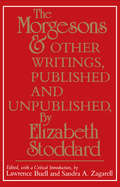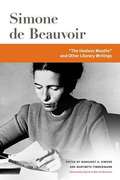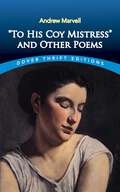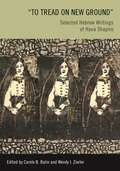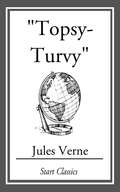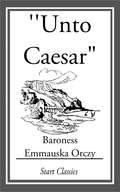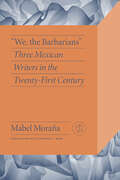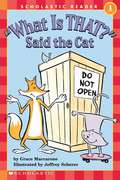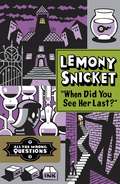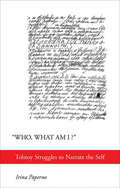- Table View
- List View
"Slowly, Slowly, Slowly," said the Sloth
by Eric CarleSlowly, slowly, slowly . . . that's the way the sloth moves. Slowly, it eats and then, slowly, it falls asleep. "What strange kind of creature is this?" the other animals wonder. Why doesn't it run or fly or play or hunt like the rest of us? "Why are you so slow?" the howler monkey inquires. But the sloth doesn't answer any questions until the jaguar asks, "Why are you so lazy?" Anyone who has ever felt too busy will appreciate the sloth's peaceful lifestyle and realize that it's okay to take time to enjoy life. Eric Carle' s dazzling collage illustrations introduce readers to the exotic beauty of the Amazon rain forest and the many unusual animals living there.
"Smelly" Kelly and His Super Senses: How James Kelly's Nose Saved the New York City Subway
by Beth AndersonNSTA Best STEM Book James "Smelly" Kelly used his super-senses and intelligence to make sure that the New York City subway in the 1930s ran safely throughout his lifetime and beyond.James Kelly smelled EVERYTHING: rats in the shed; circus elephants a mile away; tomorrow's rain. His sense of smell was EXTRAORDINARY. But what good was a powerful nose? How could his super-sniffer make him special? In the New York City subway, James found his calling--and earned the nickname "Smelly" Kelly. Armed with his super-sniffer and the tools he invented, he tracked down leaks from the dangerous to the disgusting, from the comical to the bizarre. Then, he sprang into action to prevent cave-ins and explosions in the tunnels beneath the city. Smelly Kelly not only hunted leaks but also saved lives--and he discovered the truly extraordinary power inside him. Beth Anderson's fast-paced text and Jenn Harney's comical illustrations bring to life this everyday superhero.
"Something Urgent I Have to Say to You": The Life and Works of William Carlos Williams
by Herbert LeibowitzHerbert Leibowitz's "Something Urgent I Have to Say to You" provides a new perspective on the life and poetry of the doctor poet William Carlos Williams, a key American writer who led one of the more eventful literary lives of the twentieth century. Friends with most of the contemporary innovators of his era-Ezra Pound, James Joyce, Ford Madox Ford, and Louis Zukofsky, among others-Williams made a radical break with the modernist tradition by seeking to invent an entirely fresh and singularly American poetic, whose subject matter derived from the everyday lives of the citizens and poor immigrant communities of northern New Jersey. His poems mirrored both the conflicts of his own life and the convulsions that afflicted American society-two world wars, a rampaging flu pan-demic, and the Great Depression.Leibowitz's biography offers a compelling description of the work that inspired a seminal, controversial movement in American verse, as well as a rounded portrait of a complicated man: pugnacious and kindly, ambitious and insecure, self-critical and imaginative. "Something Urgent I Have to Say to You" is both a long-overdue assessment of a major American writer and an entertaining examination of the twentieth-century avant-garde art and poetry scene, with its memorable cast of eccentric pioneers, including Marcel Duchamp, Man Ray, Marianne Moore, and Gertrude Stein.
"TOKOIRI."
by Hildred Billings Laura CarlettiLa serie REN'AI RENSAI offre uno sguardo su una relazione lesbica lungo il corso di decenni, raccontandola in ordine non cronologico tramite romanzi, romanzi brevi, novelle e racconti. "TOKOIRI." Il grande giorno è finalmente arrivato: dopo aver attraversato un oceano e aver speso metà dei risparmi di una vita, Aiko sta per sposare Reina, la donna che ama da più di vent'anni. Il vestito è perfetto, la giornata di dicembre soleggiata, e Reina si è davvero presentata alla cerimonia, ma qualcosa turba Aiko - il "tokoiri," ossia la consumazione del matrimonio. Nonostante abbia passato gran parte delle notti con Reina, Aiko si è convinta che tutto sarà diverso ora che sono sposate. Dalle nozze agli sfottò di mezzanotte, con quanto ne passa in mezzo, il "tokoiri" potrebbe distruggere quanto rimasto della sua sanità mentale! "TOKOIRI." si svolge il 17 dicembre 2012 NOTA - contiene: *Linguaggio esplicito *Scene di sesso *Poliamore/relazioni aperte *Disforia di genere *Tanto amore per donne che amano donne Riservato a un pubblico maturo
"Tata et le Bébé" - Ecrit et illustré par Amanda Monsue
by Amanda Monsue Solange Collings"Tata et le Bébé" est inspiré de toutes les Tatas créatives et espiègles du monde entier ! Il s'agit d'une histoire toute simple racontant la première rencontre entre une jeune Tata et un Bébé. Tout d'abord, elle ne sait pas trop QUOI faire du Bébé, mais, peu à peu, ils s'attachent l'un à l'autre et deviennent les meilleurs amis du monde, prêts à embarquer pour vivre ensemble de merveilleuses aventures.
"That Tongue Be Time": Norma Cole and a Continuous Making (Path to Open)
by Dale M. SmithOriginally from Canada, Norma Cole is a revered writer and visual artist who has authored and translated over thirty books and chapbooks. Though highly esteemed internationally in both visual art and poetry circles, Cole&’s association with the New College of California and her influence on artists and poets has been overlooked by scholars. In &“That Tongue Be Time,&” Dale M. Smith seeks to remedy this oversight by bringing together sixteen noted scholars, editors, and poets to examine Cole&’s poetry, translations, and visual art in order to place her within the larger scholarly conversation about contemporary poetry and poetics. The book also includes a number of black-and-white reproductions of Cole&’s art and a contextual introduction by Smith. &“That Tongue Be Time&” provides a groundbreaking look at Norma Cole&’s lasting influence on multiple generations of poets, visual artists, and scholars and should be on the shelf of anyone interested in contemporary poetry.
"That the People Might Live": Loss and Renewal in Native American Elegy
by Arnold KrupatThe word "elegy" comes from the Ancient Greek elogos, meaning a mournful poem or song, in particular, a song of grief in response to loss. Because mourning and memorialization are so deeply embedded in the human condition, all human societies have developed means for lamenting the dead, and, in "That the People Might Live" Arnold Krupat surveys the traditions of Native American elegiac expression over several centuries.Krupat covers a variety of oral performances of loss and renewal, including the Condolence Rites of the Iroquois and the memorial ceremony of the Tlingit people known as koo'eex, examining as well a number of Ghost Dance songs, which have been reinterpreted in culturally specific ways by many different tribal nations. Krupat treats elegiac "farewell" speeches of the eighteenth and nineteenth centuries in considerable detail, and comments on retrospective autobiographies by Black Hawk and Black Elk.Among contemporary Native writers, he looks at elegiac work by Linda Hogan, N. Scott Momaday, Gerald Vizenor, Sherman Alexie, Maurice Kenny, and Ralph Salisbury, among others. Despite differences of language and culture, he finds that death and loss are consistently felt by Native peoples both personally and socially: someone who had contributed to the People's well-being was now gone. Native American elegiac expression offered mourners consolation so that they might overcome their grief and renew their will to sustain communal life.
"The Abencerraje" and "Ozmin and Daraja"
by Barbara Fuchs Aaron J. Ilika Larissa Brewer-GarciaSince its publication in 1561, an anonymous tale of love, friendship, and chivalry has captivated readers in Spain and across Europe. "The Abencerraje" tells of the Moorish knight Abindarráez, whose plans to wed are interrupted when he is taken prisoner by Christian knights. His captor, a Spanish governor, befriends and admires the Moorish knight, ultimately releasing him to marry his beloved. Their enormously popular tale was repeated or imitated in numerous ballads and novels; when the character Don Quixote is wounded in his first sortie, he imagines himself as Abindarráez on the field.Several decades later, in the tense years leading up to the expulsion of the Moriscos from Spain, Mateo Alemán reprised themes from this romance in his novel Guzmán de Alfarache. In his version, the Moorish lady Daraja is captured by the Catholic monarchs Ferdinand and Isabel; she and her lover Ozmín are forced to engage in a variety of ruses to protect their union until they are converted to Christianity and married. Though "Ozmín and Daraja" is more elaborate in execution than "The Abencerraje," both tales show deep sympathy for their Moorish characters.Faithfully translated into modern, accessible English, these finely wrought literary artifacts offer rich imaginings of life on the Christian-Muslim frontier. Contextualized with a detailed introduction, along with contemporary legal documents, polemics, and ballads, "The Abencerraje" and "Ozmín and Daraja" reveals early modern Spain's profound fascination with the Moorish culture that was officially denounced and persecuted. By recalling the intimate and sympathetic bonds that often connected Christians to the heritage of Al-Andalus, these tales of romance and companionship offer a nuanced view of relationships across a religious divide.
"The Bagnios of Algiers" and "The Great Sultana"
by Miguel De Cervantes Barbara Fuchs Aaron J. IlikaBest known today as the author of Don Quixote--one of the most beloved and widely read novels in the Western tradition--Miguel de Cervantes Saavedra (1547-1616) was a poet and a playwright as well. After some early successes on the Madrid stage in the 1580s, his theatrical career was interrupted by other literary efforts. Yet, eager to prove himself as a playwright, shortly before his death he published a collection of his later plays before they were ever performed.With their depiction of captives in North Africa and at the Ottoman court, two of these, "The Bagnios of Algiers" and "The Great Sultana," draw heavily on Cervantes's own experiences as a captive, and echo important episodes in Don Quixote. They are set in a Mediterranean world where Spain and its Muslim neighbors clashed repeatedly while still remaining in close contact, with merchants, exiles, captives, soldiers, and renegades frequently crossing between the two sides. The plays provide revealing insights into Spain's complex perception of the world of Mediterranean Islam.Despite their considerable literary and historical interest, these two plays have never before been translated into English. This edition presents them along with an introductory essay that places them in the context of Cervantes's drama, the early modern stage, and the political and cultural relations between Christianity and Islam in the early modern period.
"The Fact of the Matter" - Free Short Story
by Madeleine L 'EngleEnjoy this free short story from award-winning author Madeleine L'Engle's newest book, The Moment of Tenderness, a collection of 18 short stories, some never before published. It was a frigid winter day when Old Mrs. Campbell stormed into the Franklins' general store, decrying the devilish nature of her daughter-in-law-a sentiment that deeply disturbed Mrs. Franklin, considering the woman in question, Alicia, was oft described as "saintly" by everyone around her. When she leaves the store in a huff, Mrs. Franklin thinks she's done with Mrs. Campbell's ravings for the day-until the woman calls her late in the night, urgently demanding to see her. Blending elements of fantasy and horror, what transpires between the two women over the course of the evening will test the boundaries of reason, faith, and family-and prove that, in times of great danger, even strangers can come together to help one another in need. For more stories by Madeleine L'Engle, read The Moment of Tenderness, available now.
"The Farce of the Fart" and Other Ribaldries
by Jody EndersWas there more to medieval and Renaissance comedy than Chaucer and Shakespeare? Bien sûr. For a real taste of saucy early European humor, one must cross the Channel to France. There, in the fifteenth and early sixteenth centuries, the sophisticated met the scatological in popular performances presented by roving troupes in public squares that skewered sex, politics, and religion. For centuries, the scripts for these outrageous, anonymously written shows were available only in French editions gathered from scattered print and manuscript sources. Now prize-winning theater historian Jody Enders brings twelve of the funniest of these farces to contemporary English-speaking audiences in "The Farce of the Fart" and Other Ribaldries. Enders's translation captures the full richness of the colorful characters, irreverent humor, and over-the-top plotlines, all in a refreshingly uncensored American vernacular.Those who have never heard the one about the Cobbler, the Monk, the Wife, and the Gatekeeper should prepare to be shocked and entertained. "The Farce of the Fart" and Other Ribaldries is populated by hilarious characters high and low. For medievalists, theater practitioners, and classic comedy lovers alike, Enders provides a wealth of information about the plays and their history. Helpful details abound for each play about plot, character development, sets, staging, costumes, and props. This performance-friendly collection offers in-depth guidance to actors, directors, dramaturges, teachers, and their students."The Farce of the Fart" and Other Ribaldries puts fifteenth-century French farce in its rightful place alongside Chaucer, Shakespeare, commedia dell'arte, and Molière--not to mention Monty Python. Vive la Farce!
"The Fat of the Land"
by Anzia YezierskaA mother goes from poverty to wealth, expecting happiness but only finding a cruel Catch-22. Anzia Yezierska wrote about the struggles of female Jewish immigrants in New York's Lower East Side. She confronted the cost of acculturation and assimilation among immigrants. Her stories provide insight into the meaning of liberation for immigrants—particularly Jewish immigrant women.
"The Gift" by H.D.: The Complete Text
by H. D."It is a special joy to have the complete text of The Gift, a stunning work in the H.D. canon, a work of import for studies in autobiography and the essay, for understanding the spiritual crisis of modernism, and as a climactic work in the career of an extraordinary 20th-century woman writer."--Rachel Blau DuPlessis, Temple University"All students and teachers of American literature will value this book for the light it throws on the poet who is, I believe, the most important female poet in America since Emily Dickinson, and indeed the most important female poet writing in the English language during the 20th century."--Louis L. Martz, Yale UniversityIn this complete, unabridged edition of H.D.'s visionary memoir, The Gift, Jane Augustine makes available for the first time the text as H.D. wrote it and intended it to be read, including H.D.’s coda to the book, her "Notes," never before published in its entirety.Written in London during the blitz of World War II, The Gift re-creates the peaceful childhood of Hilda Doolittle in Bethlehem, Pennsylvania, where she was born in 1886. As an antidote to war’s destructiveness, H.D. invokes the mystical Moravian heritage of her mother's family to convey an ideal world peace and salvation that would come through the spiritual power of women--a power that also endowed her with "the gift" of her own art.Although H.D.’s androgynous signature first associated her with early 20th-century Imagist poetics, The Gift exemplifies her continuing innovations in prose. She uses the child-voice, flashback, and stream-of-consciousness techniques reminiscent of Virginia Woolf, Gertrude Stein, and Dorothy Richardson, but expands the genre of memoir through free-associative meditations on myth and her lengthy essayistic "Notes" on Moravian history, emphasizing the pioneer missionaries' rapport with Native Americans..The Gift is key to intertextual studies of H.D.’s wartime oeuvre and to an understanding of the religious and gender concerns pervading her later work, especially the women-centered poems Trilogy and Helen in Egypt. Augustine’s introduction and annotations, based on extensive research in Moravian archives, provide a biographical and historical context to make this the definitive edition of The Gift, essential to students and scholars of H.D., modernism, and feminist literature.
"The Good War": An Oral History of World War II
by Studs TerkelWinner of the Pulitzer Prize: &“The richest and most powerful single document of the American experience in World War II&” (The Boston Globe). &“The Good War&” is a testament not only to the experience of war but to the extraordinary skill of Studs Terkel as an interviewer and oral historian. From a pipe fitter&’s apprentice at Pearl Harbor to a crew member of the flight that dropped the atomic bomb on Nagasaki, his subjects are open and unrelenting in their analyses of themselves and their experiences, producing what People magazine has called &“a splendid epic history&” of WWII. With this volume Terkel expanded his scope to the global and the historical, and the result is a masterpiece of oral history. &“Tremendously compelling, somehow dramatic and intimate at the same time, as if one has stumbled on private accounts in letters locked in attic trunks . . . In terms of plain human interest, Mr. Terkel may well have put together the most vivid collection of World War II sketches ever gathered between covers.&” —The New York Times Book Review &“I promise you will remember your war years, if you were alive then, with extraordinary vividness as you go through Studs Terkel&’s book. Or, if you are too young to remember, this is the best place to get a sense of what people were feeling.&” —Chicago Tribune &“A powerful book, repeatedly moving and profoundly disturbing.&” —People
"The Man Who Thought Himself a Woman" and Other Queer Nineteenth-Century Short Stories
by Christopher Looby"Perhaps it is no coincidence that the nineteenth century--the century when, it has been said, sexuality as such (and various taxonomized sexual identities) were invented--is the period when American short stories were invented, and when they were the queerest."--Christopher Looby, from the IntroductionA man in small-town America wears the clothing of his wife and sisters; satisfied at last that he has "a perfect suit of garments appropriate for my sex," he commits suicide, asking only that he be buried dressed as a woman. A country maid has a passionate summer relationship with an heiress, the memory of which sustains her for the next forty years. A girl is carried by a strong wind to a place where she discovers that everything is made of candy, including the "queer people," whom she licks and eats. If these are not the kinds of stories we expect to find in nineteenth-century American literature, it is perhaps because we have been looking in the wrong places.The stories gathered here are written by a diverse assortment of writers--women and men, obscure and famous: Herman Melville, Willa Cather, Henry James, and Louisa May Alcott, among others. Exploring the vagaries of gender identity, erotic desire, and affectional attachments that do not map easily onto present categories of sex and gender, they celebrate, mourn, and question the different modes of embodiment and forgotten styles of pleasure of nineteenth-century America.
"The Morgesons" and Other Writings, Published and Unpublished
by Lawrence Buell Elizabeth Stoddard Sandra A. Zagarell"Stoddard was, next to Melville and Hawthorne, the most strikingly original voice in the mid-nineteenth-century American novel, a voice . . . that ought to gain a more sympathetic and perceptive hearing in our time than in her own."--from the IntroductionThe centerpiece of this volume is The Morgesons (1862), one of the few outstanding feminist bildungsromanae of that century. Additional selections include arresting short stories and provocative journalistic essays/reviews, plus a number of letters and manuscript journals that have never before been published. The texts are fully edited and documented.
"The Useless Mouths" and Other Literary Writings
by Simone De Beauvoir Sylvie Le Beauvoir Margaret A. Simons Marybeth Timmermann"The Useless Mouths" and Other Literary Writings brings to English-language readers literary writings--several previously unknown--by Simone de Beauvoir. Culled from sources including various American university collections, the works span decades of Beauvoir's career. Ranging from dramatic works and literary theory to radio broadcasts, they collectively reveal fresh insights into Beauvoir's writing process, personal life, and the honing of her philosophy. The volume begins with a new translation of the 1945 play "The Useless Mouths," written in Paris during the Nazi occupation. Other pieces were discovered after Beauvoir's death in 1986, such as the 1965 short novel Misunderstanding in Moscow, involving an elderly French couple who confront their fears of aging. Two additional previously unknown texts include the fragmentary "Notes for a Novel," which contains the seed of what she later would call "the problem of the Other," and a lecture on postwar French theater titled "Existential Theater." The collection notably includes the eagerly awaited translation of Beauvoir's contribution to a 1965 debate among Jean-Paul Sartre and other French writers and intellectuals, "What Can Literature Do?" Prefaces to well-known works such as Bluebeard and Other Fairy Tales,La Bâtarde, and James Joyce in Paris: His Final Years are also available in English for the first time, alongside essays and other short articles. A landmark contribution to Beauvoir studies and French literary studies, the volume includes informative and engaging introductory essays by prominent and rising scholars. Contributors are Meryl Altman, Elizabeth Fallaize, Alison S. Fell, Sarah Gendron, Dennis A. Gilbert, Laura Hengehold, Eleanore Holveck, Terry Keefe, J. Debbie Mann, Frederick M. Morrison, Catherine Naji, Justine Sarrot, Liz Stanley, Ursula Tidd, and Veronique Zaytzeff.
"To His Coy Mistress" and Other Poems (Dover Thrift Editions: Poetry)
by Andrew MarvellOne of the greatest of the metaphysical poets, Andrew Marvell (1621–78) was also among the most eclectic. His lyrics, love poems, satires, and religious and political verse display a remarkable range of styles and ideas that make him one of the most interesting and rewarding poets to study. In addition to their complexity and intellectual rigor, Marvell's poems abound in captivating language and imagery.This collection includes such masterpieces as "To His Coy Mistress," "The Definition of Love," "The Garden," "The Coronet," "A Dialogue Between the Soul and the Body," "On a Drop of Dew," "An Horatian Ode Upon Cromwell's Return from Ireland," "Upon Appleton House," and many others. Ideal for use in English literature courses, high school to college, this volume will appeal to poetry lovers everywhere.
"To Tread on New Ground": Selected Hebrew Writings of Hava Shapiro
by Carole B. Balin Wendy I. ZierlerHava Shapiro is among the nearly forgotten Jewish women writers who sought acceptance in Jewish literary circles of the last century. Born in Slavuta (modern-day Ukraine) in 1878, she published works of fiction, memoir, literary criticism, and journalism, including a volume of short fiction and a scholarly monograph on the Czech leader Masaryk. Her handwritten diary--the first known diary to be kept by a woman in Hebrew--evokes not only the momentous events of her day but also the experiences of women like herself who failed to follow the dictates of Jewish tradition and aspired to roles beyond those of wife and mother. In "To Tread New Ground": Selected Writings of Hava Shapiro, editors and translators Carole B. Balin and Wendy I. Zierler present an English anthology of Shapiro's late-nineteenth- and early-twentieth-century Hebrew writings. The selection culls from her short fiction, feminist literary criticism, reportage and literary essays, as well as her diary and hundreds of letters. Shapiro chronicled, publicly and privately, such cataclysmic events as the Russian Revolution and both World Wars in addition to critical episodes in the Jewish past, including pogroms, mass migration, ruptures in traditional Jewish life, and the development of Zionism. A list of Shapiro's intimates, whom she describes in both her diary and published reminiscences, reads like a "who's who" of the Russian Haskalah, including Y. L. Peretz, Reuven Brainin, David Frischmann, Nahum Sokolov, Micha Yosef Berdischevsky, and Hayim Nahman Bialik. To further contextualize Shapiro's writings, Balin and Zierler include a thorough introduction and translations of critical essays about Shapiro. Balin and Zierler's Hebrew edition of Shapiro's writing, Behikansi atah, which was published in Israel in 2008, brought the first broad attention and readership to Shapiro's remarkable biography and writings. The translations in "To Tread New Ground," which include previously uncollected materials, will be welcomed by English-speaking readers interested in Hebrew literature, East European Jewish history, and gender studies.
"Topsy-Turvy"
by Jules Verne"Topsy-Turvy" is an adventure novel by Jules Verne, published in 1889. It is a sequel to "From the Earth to the Moon", featuring the same characters from the Baltimore Gun Club but set twenty years later. Like some other books of his later years, in this novel Verne tempers his love of science and engineering with a good dose of irony about their potential for harmful abuse and the fallibility of human endeavors.
"Unto Caesar"
by Emmauska OrczyBaroness Emma Magdolna Rozália Mária Jozefa Borbála "Emmuska" Orczy de Orczi (23 September 1865 - 12 November 1947) was a Hungarian-born British novelist, playwright and artist of noble origin. She is most known for her series of novels featuring the Scarlet Pimpernel. This is one of her novels.
"We, the Barbarians": Three Mexican Writers in the Twenty-First Century (Critical Mexican Studies)
by Mabel Moraña&“We, the Barbarians&” embarks on a careful and exhaustive reading of three of the most prominent authors in the latest wave of Mexican fiction: Yuri Herrera, Fernanda Melchor, and Valeria Luiselli. Originally published in Mexico in 2021, this work is divided into three parts, one for each author&’s narrative production. The book analyzes all of the literary works published by Herrera, Melchor, and Luiselli from the beginning of their writing careers until 2021, allowing for a diachronic interpretation of their respective narrative projects as well as for comparative approaches to their aesthetic and ideological contours. Characterized by the fragmentation of civil society and the decomposition of the myths that accompanied the consolidation of the modern nation, Mexican visual and literary arts have explored a myriad of representational avenues to approach the phenomena of violence, institutional decay, and political instability. The critical and theoretical approaches in &“We, the Barbarians&” explore a variety of alternative symbolic representations of topics such as nationalism, community, and affect in times impacted by systemic violence, precariousness, and radical inequality. Moraña perceives the negotiations between regional/local imaginaries and global scenarios characterized by the devaluation and resignification of life, both at individual and collective levels. Though it uses three authors as its focus, this book seeks to more broadly theorize the question of the relationship between literature and the social in the twenty-first century.
"What Is That?" Said the Cat
by Grace Maccarone Jeffrey Scherer"I found a box", said the fox. "I heard", said the bird. This simple, rhyming, Level 1 "Hello Reader" features the very first sight words new readers learn. Full color. Includes image descriptions.
"When Did You See Her Last?" (All the Wrong Questions #2)
by Lemony Snicket SethI should have asked the question "How could someone who was missing be in two places at once?" Instead, I asked the wrong question -- four wrong questions, more or less. This is the account of the second.In the fading town of Stain'd-by-the-Sea, young apprentice Lemony Snicket has a new case to solve when he and his chaperone are hired to find a missing girl. Is the girl a runaway? Or was she kidnapped? Was she seen last at the grocery store? Or could she have stopped at the diner? Is it really any of your business? These are All The Wrong Questions.
"Who, What Am I?": Tolstoy Struggles to Narrate the Self
by Irina Paperno"God only knows how many diverse, captivating impressions and thoughts evoked by these impressions . . . pass in a single day. If it were only possible to render them in such a way that I could easily read myself and that others could read me as I do. . ." Such was the desire of the young Tolstoy. Although he knew that this narrative utopia—turning the totality of his life into a book—would remain unfulfilled, Tolstoy would spend the rest of his life attempting to achieve it. "Who, What Am I?" is an account of Tolstoy's lifelong attempt to find adequate ways to represent the self, to probe its limits and, ultimately, to arrive at an identity not based on the bodily self and its accumulated life experience. This book guides readers through the voluminous, highly personal nonfiction writings that Tolstoy produced from the 1850s until his death in 1910. The variety of these texts is enormous, including diaries, religious tracts, personal confessions, letters, autobiographical fragments, and the meticulous accounts of dreams. For Tolstoy, inherent in the structure of the narrative form was a conception of life that accorded linear temporal order a predominant role, and this implied finitude. He refused to accept that human life stopped with death and that the self was limited to what could be remembered and told. In short, his was a philosophical and religious quest, and he followed in the footsteps of many, from Plato and Augustine to Rousseau and Schopenhauer. In reconstructing Tolstoy's struggles, this book reflects on the problems of self and narrative as well as provides an intellectual and psychological biography of the writer.
